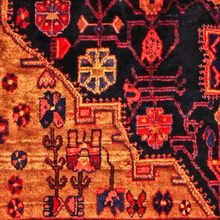Kolyai Rug
| Kolyai Rug | |
|---|---|
 Design of Kolyai Rug (Rugman) | |
| General information | |
| Name | Kolyai Rug |
| Original name | قالی کلیایی |
| Alternative name(s) | Kolyai Carpet |
| Origin | |
| Category | Village, Tribal |
| Technical information | |
| Common designs | Herati, Geometric |
| Common colors | Blue, Red, Camel, Navy Blue |
| Dyeing method | Natural, Synthetic |
| Pile material | Wool |
| Foundation material | Cotton |
| Knot type | Symmetrical (Turkish) |
Kolyai are tribal rugs made by nomadic Kurdish people of western Iran. They show bright and lively colors, usually with a large central medallion in hexagonal Herati diamond design and beveled spandrels. Their products were not originally made to be sold, but intended as practical dowry articles such as floor coverings, blankets, storage bags, saddle blankets, or as insurance against future hard times. Many Kolyai carpets are runners of great length, 20 to 40 feet being common.
History
Kolyai is the name of a Kurd subtribe living across the Hamadan and Kermanshah Provinces of the western Iran region. Kolyai rugs are known in the antique rug market from the late eighteenth century and are marketed mostly as Kurd carpets. Kolyai rugs are categorized in the Iranian market as mosur, Rugs, and can be found in the Hamadan, Kermanshah, and Tehran bazaars.
Kolyai designs are nomadic with geometric patterns in either an allover or medallion style. The weavings have tribal flower heads, large palmettes, Star motifs, lozenge-shaped designs surrounded with Hook motifs, animals, birds, and other primitive designs.
The rug tonality emphasizes dark blue or reds interchangeably for the field and border. In addition, shades of blue, brown, camel, green, black, and beige are used for the minor borders, design elements, and outlines.
Kolyai rugs generally range from medium to good in grade quality. They have a wool or cotton foundation and a wool pile. The Turkish (symmetric) knot is always employed.
Sizes made by Kolyai weavers range from three feet to five feet in width by six feet to nine feet in length. Small bags, tribal items, runners, and large gallery sizes up to approximately twenty-two feet by ten feet are also made. Early Kolyai rugs that measure approximately eight feet by four feet can have a market value up to $10000.[1]
See also
| Search for Kolyai Rug on Wikipedia. |
References
- ↑ Moheban, 2015, 321
Bibliography
- Abraham Levi Moheban. 2015. The Encyclopedia of Antique Carpets: Twenty-Five Centuries of Weaving. NewYork: Princeton Architectural Press.